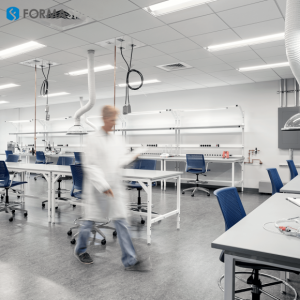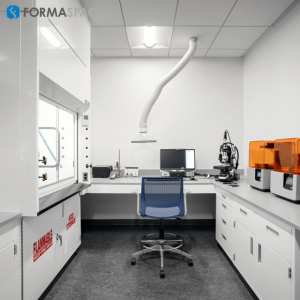Create a Culture of Lab Safety: Interview with Dr. James Kaufman of the Laboratory Safety Institute

Formaspace manufactured this Benchmarx™ for a university lab in California; it features a black epoxy sink and countertop and two phenolic resin upper shelves.
We talk lab safety with Dr. James Kaufman, Founder of the Laboratory Safety Institute, to find out how the lab community can build safer working conditions.
Dr. Kaufman, who goes by Jim, was kind enough to join us in an extended Zoom call to discuss how he got started his lab safety career and what tips he can share with architects, facility planners, lab managers, academic partners, as well as others who are interested in improving lab safety.
Two Accidents In The First Month Of A Career As A Professional Chemist
Two accidents marked the start of Jim Kaufman’s first month working at Dow Chemical in Wayland, Massachusetts – incidents that were to change the course of Jim’s laboratory career forever, setting him on his lifelong mission to promote lab safety.
The first accident was caused by Jim himself, working as the new guy in Dow’s chemistry laboratory.
As he mixed tertiary butyl alcohol in DMSO with potassium metal in a round-bottomed flask, it suddenly ignited, turning the glassware into a Roman candle with purple flames and black smoke. The spewing flames quickly emptied the building. Fortunately, no one was injured, but the next day, the lab manager sarcastically thanked the sheepish “Dr. Kaufman” for his colorful display of pyrotechnics but also pointedly asked if he could please save them for the next 4th of July celebrations instead.
The second accident that took place during Jim’s first month at Dow was much more serious, causing a life-changing injury at the lab of his alma mater, the Worcester Polytechnic Institute, where Jim had received his Ph.D. in chemistry and had recently concluded his postdoctoral work.
Jim got the news of the accident from a radio news report as he was driving home after work at Dow. He quickly diverted to the scene of the accident, which had taken place just hours before. Upon arrival, he was shocked to find the force of the explosion had taken down all of the ceiling light fixtures, blown out all the laboratory windows and completely obliterated the entire corner of a lab workbench. Worse news was yet to come: the graduate student working in the lab had lost fingers on both hands in the explosion.
In the aftermath of these accidents, Jim realized that – despite his many years of experience working in chemistry labs as an undergraduate, graduate student, and a most recently a post doc – he lacked the kind of rigorous lab safety training that he was only now receiving as a new hire at Dow Chemical. In other words, the education system had left him utterly unprepared for how to conduct safer lab operations.
Here is where he could make a contribution, Jim told himself. In his first month at Dow, he had learned more about best practices in laboratory safety than he ever had during his 25-plus years of school – and he had the opportunity to share what he was learning at Dow with students at schools and colleges across the country, and around the world.
Promoting safety in the laboratory would become Jim’s crusade.
With Dow’s permission, Jim wrote the first edition of Laboratory Safety Guidelines. Two thousand copies were distributed at first; then, to meet the unexpected demand, 250,000 copies were printed.
Today, Laboratory Safety Guidelines has been translated into 22 languages, and over 6 million copies have been distributed.
The Laboratory Safety Institute Offers A Vast Range Of Safety Resources, Many Of Them Free Or Available At Low Cost.
Building on the success of his Laboratory Safety Guidelines publication, Jim first created a lab safety program in 1970 at Curry College in Milton, Massachusetts; in time, it grew to become its own independent 501c3 non-profit Massachusetts charity organization, known today as the Laboratory Safety Institute.
Jim has led the organization full time since his retirement from Dow Chemical in the late 1990s, supported by a small staff and group of adjunct faculty members.
Together, this team offers a wide array of safety resources to the laboratory community, many of which are now available as remote resources due to the Covid-19 pandemic:
Safety Resources For K-12, Higher Education, Commercial, Or Non-Profit Laboratories
Safety-related publications, audio-visual materials, safety posters, and more are available on the website’s Resources and Shop pages (including the free Laboratory Safety Guidelines publication and the 3-volume series Learning by Accident).
Online Classes With Certificates And Continuing Education Credits
The Laboratory Safety Institute currently offers a variety of courses, including this online lab safety series:
1. How to be a more Effective Chemical Hygiene Officer
2. Introduction to Lab Safety (1-day)
3. Extended Lab Safety (2-days)
4. Comprehensive Lab Safety (3-days)
Certificates of achievement are awarded to all who pass course exams. Course participants can earn graduate academic credit via an affiliation with the University of San Diego.
Online Safety Seminars
A Prudent Practices Roundtable safety seminar is available for viewing or listening on the website.
Virtual On-Site Lab Facility Audits/Evaluations
Virtual lab safety audits and site evaluations (due to the pandemic, these are now done virtually). Recent clients include an oil refinery and a community college.
Safety Documents Reviews And Evaluations
Evaluation of safety programs and safety protocol documents, including a complimentary “wellness check” evaluation (with 10 tips) of chemical hygiene plans submitted by lab managers and administrators.
Consultations
The Laboratory Safety Institute also engages directly with both academic institutions and non-academic organizations to provide educational consultation services, including facilities audits, program evaluations, reviews of safety documents, and more.
Expert Witness Services
A few times a year, the Laboratory Safety Institute is called on to provide expert testimony in lab safety-related litigation proceedings.
Jim reminds us that while the Laboratory Safety Institute offers many products and services at low cost (or even for free) the success of the programs depends greatly on the generous support of the lab community – in the form of membership dues, volunteer service, charitable contributions, financial grants and more. Members receive additional safety resources at no charge.
Jim hopes you can keep the organization’s good works in mind as we enter the close of a difficult year. And we note that the IRS is allowing all taxpayers to deduct gifts of up to $300 this year, even if they don’t itemize, thanks to a provision in the 2020 CARES Act for Covid-19 pandemic relief.
How Can We Learn From The Lab Accident Mistakes Of The Past, Or Are We Destined To Repeat Them?
We wanted to get Jim’s take on preventing lab accidents. Are we destined to repeat the failures of the past, or can we learn from past mistakes?
In Jim’s view, life is full of hazards: chemical, physical, biological, mechanical, radiation, noise, hi/lo pressure, electrical, and stress. Safety is a judgment about the acceptability of risk. Driving a car is risky, but that doesn’t mean we shouldn’t try to reduce the likelihood of having an accident. After all, we wear seatbelts and (hopefully) signal to other motorists before changing lanes.
The reality is there are many near-miss accidents, ones that we should learn from. LSI has a collection of over 5,000 anecdotal accounts of lab accidents. Jim points out that there are over 1,500 examples of accidents laid out in the 3-volume set Learning by Accident, published by the Laboratory Safety Institute.
Fortunately, the majority of these resulted in no one getting seriously hurt. Nonetheless, they offer clear warning signs that we need to recognize and act on. “Don’t wait for the accident!” says Jim. “People always say ‘this never happened before’ after the accident. I say that may be true, but by then, it’s too late!”
Jim provides a couple of examples of flashing safety warning signs that went unnoticed for years.
In his first example, Jim recounts visiting a hospital where the corridor floors in the public areas were especially slippery. When he asked the staff about it, the response was along the lines of ‘yeah, you think it’s bad here, you should go into the lab.’ Jim later discovered that technicians in the hospital’s histology lab were using paraffin to make sample slides, and the wax residues were falling to the floor, only to be tracked throughout the lab and into the corridors of the hospital, creating a major slip and fall risk. (See the Formaspace report on industrial workplace accidents, where slips and falls top the list of most expensive and debilitating on-the-job accidents.)
Read more...
Julia Solodovnikova
Formaspace
+1 800-251-1505
email us here
Visit us on social media:
Facebook
Twitter
LinkedIn
Legal Disclaimer:
EIN Presswire provides this news content "as is" without warranty of any kind. We do not accept any responsibility or liability for the accuracy, content, images, videos, licenses, completeness, legality, or reliability of the information contained in this article. If you have any complaints or copyright issues related to this article, kindly contact the author above.


